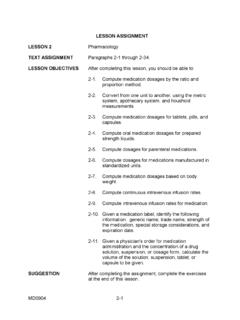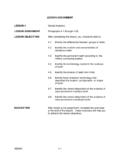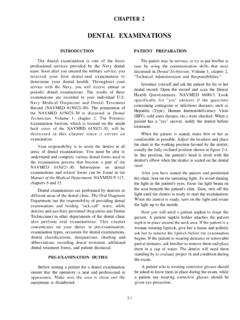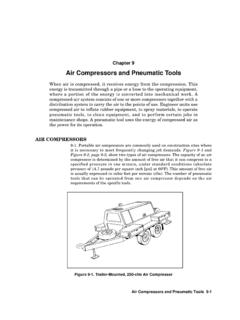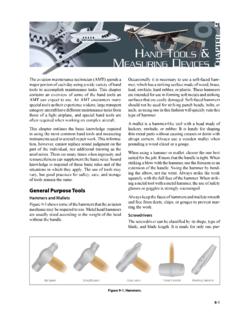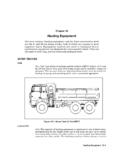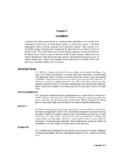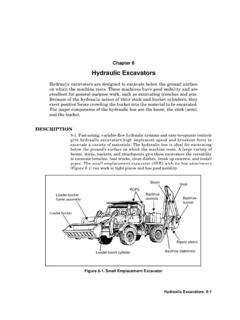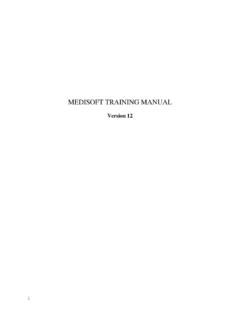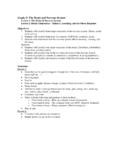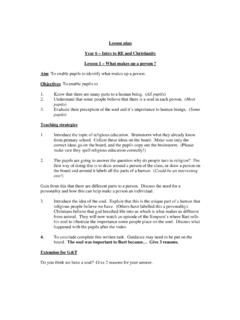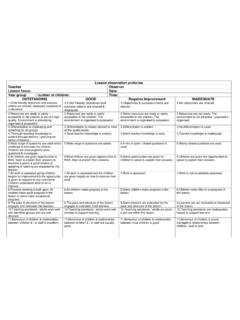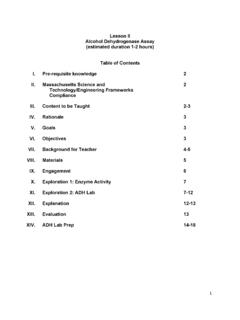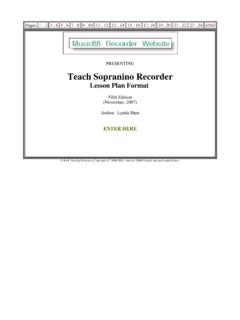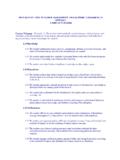Transcription of LESSON ASSIGNMENT LESSON OBJECTIVES
1 md0913 1-1 LESSON ASSIGNMENTLESSON 1 Dosage CalculationsLESSON ASSIGNMENTP aragraphs 1-1 through 1-25 LESSON OBJECTIVESA fter completing this LESSON , you should be able to:1-1 Interpret drug units within the metric units between the apothecary andmetric the strength of a drug, calculate andmeasure an injection an antibiotic or other drug in dry powderform, dilute the vial with an appropriate diluentand calculate the necessary volume pediatric doses, given the body weightand either the dose per unit of body weight orthe dose per unit of surface you need to review basic mathematics, it isrecommended that you enroll in Subcourse MD0900,Basic studying this ASSIGNMENT , complete the exercisesat the end of this LESSON .
2 These exercises will help youto achieve the LESSON 1-2 LESSON 1 DOSAGE CALCULATIONSS ection I. INTERPRETING MEDICAL MEDICAL ABBREVIATIONSTo calculate doses and administer drugs, you must be familiar with thoseabbreviations commonly used in medicine, especially those found in prescriptions andclients' charts. Table 1-1 is a list of common Latin terms and abbreviations used inmedicine. Tables 1-2 and 1-3 are summaries of common abbreviations used to indicatetimes of administration, routes of administration, and dosage forms. Tables 1-4 and 1-5give symbols or abbreviations for different units of NUMERALSR oman numerals are used in writing prescriptions. They are used to specify theamounts of ingredients when the apothecary system is being used.
3 They are used tospecify the number of units (capsules, tablets, powders, suppositories, and so forth) tobe dispensed; for example, "Dispxxiv." And lastly, they are used in the signa ordirections to the client. You should, therefore, be thoroughly familiar with the system ofRoman numerals used in pharmacy. The basic symbols or numerals are:ss, 1/2I1V5X10L50C100D500M1000 These basic numerals may be combined to represent any number, and there aredefinite rules for the manner in which they are combined. Upper-case or lower-caseletters may be used for Roman numerals. Prescribers usually prefer uppercase letters,but they dot the "I" for the sake of clarity. The rules for Roman numerals are as Except for "ss" meaning one-half (1/2), all other fractions arerepresented by Arabic numerals (1/4, 3/8, 1/120, and so forth).
4 (Note: The "ss" may bewritten with or without a bar--ss or .) Numerals. Numerals may be repeated. When they are, thevalue of the number is repeated. Thus, iii or III is 3 (1+1+1), XXX is 30 (10+10+10), andCCC is 300 (100+100+100). Any numeral that would be the same as another when md0913 1-3 Table 1-1. Common Latin terms and abbreviations (continued).TERM OR PHRASEABBREVIATIONMEANING adto, up toad libitumad libfreely, at pleasureana of , goodbistwicebis in a the client _cumcwithdentur tales , of such modo the manner pre-scribed (as directed)fac, fiat, , let it be , guttaegt., , dropshorahor., somnihor.
5 Som., the hour of repetaturnon rep., non not repeatMD0913 1-4 Table 1-1. Common Latin names and abbreviations (concluded).TERM OR eyeoculus , eyeoculi eyesomni horaOmn. hourperthrough, by means ofper mouthplaceboI will satisfypost cibumpost cib., mealspro re needed, ascircumstances sufficient quantityquantum satis ada sufficient quantityto dayquaque hourquater in die times a dayrecipeRxtake thousemi, semisssa , label _ sineswithoutsolve, solvere, in , tidthree times ointmentut dictumUt directedMD0913 1-5 Table 1-2. Times of 1-3.
6 Routes of administration and dosage 1-4. Metric system 1-5. Apothecary system , bidtwice a , qidfour times a , q3hevery 3 hoursnon repdo not , q6hevery 6 , tidthree times a , , , , , , , , dramdramfluid ouncefl. oz., ounceoz., pintO., , : The fluid dram and the fluid ounce are often abbreviated without the f beingused. It can be assumed that when the dram symbol is used with a liquid, thefluid dram is 1-6repeated is NOT repeated. For example, VV is NOT used for 10 (5+5) because X is 10and LL is NOT used for 100 (50+50) because C = 100). Numerals Before Larger. When a smaller numeral placed before alarger one, the smaller value is subtracted from the larger one.
7 Only one number canbe subtracted in this way. Thus, IV (5 - 1) = 4; IX (10 - 1) = 9; and XC (100 - 10) = 90are correct, but 3 is never written Numerals After Larger. A smaller numeral placed after a larger oneis added to the larger number. For example, VIII = (5+3) = 8 ; XIII = (10+3) = 13; CLX =(100+50+10) = Numeral Between Two Larger. A smaller numeral between twolarger ones is ALWAYS subtracted from the larger numeral which follows it as CXL (100+ [50-10]) = 140; MCMLXXVI (1000 + [1000-100] + 50 + 10 + 10 + 5 + 1) = Use of "j." As a precaution against error, the last "i" may be replaced bya "j." When this method is used, 3 would be written as of Roman Numerals. Table 1-6 shows examples of Roman numeralsand their 1-6.
8 Examples of Roman After Modified Noun. When a number expressed in Romannumerals is used to modify a noun, the number follows the noun. The noun is likely tobe a unit of the apothecary system or a unit of dosage. For example, "gr ii" would beinterpreted as "two grains" and "caps i" would mean "one capsule."ss=1/2x=10xx=20li=51i=1xi=11xxi =21lix=59ii=2xii=12xxii=22lx=60iii=3xiii =13xxiii=23lxx =70iv=4xiv =14xxiv=24lxxx =80v=5xv=15xxv=25xc=90vi=6xvi =16xxvi=26c= 100vii=7xvii =17xxvii =27ci= 101vii=8xviii =18xxviii =28cxxi = 121ix=9xix =19xxix=29d=500m= 1000MD0913 OF ORDERS FOR DRUGSP rescribers use abbreviations extensively in writing orders for drugs.
9 Theenlisted soldier must be able to read such orders accurately. Examples of some ordersfor drugs and the interpretations are given :Tab ii stat, then tab i bidInterpretation:2 tablets at once, then 1 tablet twice a :Tsp i pc & hsInterpretation: 1 teaspoonful after meals and at : 2 ml IM stat & q12hInterpretation: 2 ml intramuscularly at once and every 12 : Tab iv stat, then tab ii q4hInterpretation: 4 tablets at once, then 2 tablets every 4 II. RATIO AND MATHEMATICSFor a review of basic mathematics, you can enroll in Subcourse MD0900, BasicMathematics, or Subcourse MED904, Pharmacology Math for the Practical MD0900 covers fundamental operations and practical problems in fractions,mixed numbers, decimals, percents, ratios, proportions, and square roots.
10 SubcourseMD0904 covers basic arithmetic, fractions, decimals, percentages, ratio and proportion,and math required for pharmaceutical OF RATIO AND PROPORTIONThe principles of ratio and proportion are tools with which the student can solvemany, if not all, dosage calculations. A firm understanding of these basics will enablethe student to deal with later sections in which common dose problems are solved byapplying simple ratio and proportion A ratio is the relation between like numbers or values, or a way to express afractional part of a whole. Ratios may be written:As a fraction: _2_ 3As a division: 2 3 With the ratio or colon sign: 2:3 Using "per": 50 miles per hour (50mi/hr)b.
